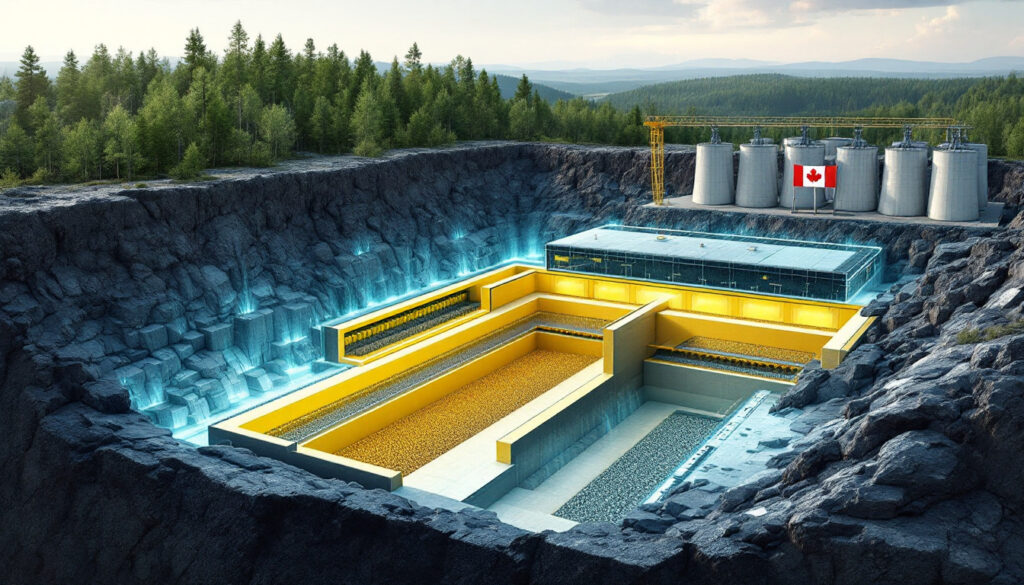Understanding Nuclear Waste Disposal
Nuclear waste disposal is a critical challenge faced by countries with nuclear energy programs. The science of nuclear waste disposal involves complex geological, chemical, and engineering considerations. Deep Geological Repositories (DGRs) have emerged as the preferred solution among experts worldwide for the permanent disposal of high-level nuclear waste.
What is Nuclear Waste?
Nuclear waste comprises materials that contain radioactive substances resulting from nuclear power generation, medical applications, research, and military activities. Unlike other industrial waste, nuclear waste requires specialized handling due to its radioactive properties and potential health risks.
Types of Nuclear Waste
Nuclear waste is classified into three main categories based on radioactivity intensity and longevity:
- Low-level waste (LLW): Contains small amounts of radioactivity and includes items like protective clothing, tools, and filters
- Intermediate-level waste (ILW): Contains higher levels of radioactivity requiring some shielding during handling and transport
- High-level waste (HLW): Primarily consists of Used Nuclear Fuel (UNF) and requires specialized disposal solutions
While low and intermediate-level waste comprise approximately 97% of all nuclear waste by volume, they contain less than 10% of the total radioactivity. High-level waste, though smaller in volume, presents the greater long-term management challenge.
Characteristics of Used Nuclear Fuel
Used Nuclear Fuel (UNF) has several distinctive properties that influence disposal requirements:
- Initially generates enough heat to melt itself, requiring underwater storage in cooling pools
- Radioactivity decreases exponentially over time as unstable isotopes decay
- After approximately 10 years, UNF can be transferred to concrete and steel dry storage containers
- Canada has accumulated approximately 60,000 tonnes of UNF since commercial nuclear power generation began in the 1960s
- UNF requires 1-10 million years to return to radioactivity levels comparable to natural uranium ore
Dr. Ian Burron, geochemistry researcher specializing in natural DGR analogues, notes: "The timeframes sound intimidating, but nature has shown us that it's entirely possible to contain these materials for even longer periods."
How Does Deep Geological Repository (DGR) Technology Work?
Deep Geological Repositories represent the culmination of decades of scientific research and engineering development. These facilities are designed to isolate nuclear waste from the biosphere for timeframes measured in hundreds of thousands to millions of years.
Multi-Barrier Defense System
DGRs employ a defense-in-depth strategy with multiple independent engineered and natural barriers:
- UNF pellets are sealed in corrosion-resistant Zircalloy tubes
- These tubes are bundled and sealed in carbon steel canisters with copper cladding
- Canisters are packed in highly compacted bentonite clay blocks
- The assemblies are placed in specially constructed tunnels at least 500m underground
- Remaining space is backfilled with additional bentonite clay
This redundant system ensures that even if one barrier fails, others remain intact. Each component has been selected based on demonstrated long-term stability and complementary protective properties.
The Role of Geology in DGR Safety
The host rock formation is perhaps the most critical component of a DGR:
- The ideal host rock must be stable and highly impervious to water movement
- The Ignace site in Ontario features granite bedrock, which is extremely waterproof when unfractured
- This Canadian Shield region has demonstrated geological stability as evidenced by Earth's oldest rocks for over 2 billion years
- The planned depth of 500-800 meters provides an optimal balance between protection and construction feasibility
- Bentonite clay absorbs water and expands, creating a self-sealing barrier around the waste containers
"The stability of the Canadian Shield is remarkable from a geological perspective," explains Dr. Burron. "Many of these rock formations have remained essentially unchanged since before complex life evolved on Earth."
Timeline for Canada's DGR Implementation
The Nuclear Waste Management Organization (NWMO) has outlined a multi-decade implementation plan:
- Site characterization and regulatory approval: approximately 10 years
- Construction phase: approximately 10 years
- Operational receiving period: approximately 40 years
- Extended monitoring period: several decades
- Final sealing and site restoration to natural state
On November 28, 2024, the NWMO selected Ignace, Ontario as the location for Canada's DGR after an extensive site selection process involving detailed geological surveys and community engagement.
Why is Deep Geological Disposal the Preferred Solution?
The scientific consensus strongly favors deep geological disposal as the safest long-term solution for high-level nuclear waste management.
Scientific Consensus
There is near-universal agreement among experts worldwide that deep burial in stable geological formations offers the optimal solution:
- Multiple independent barriers provide redundant protection against potential release pathways
- Passive safety systems require no active human or machine involvement once sealed
- The approach isolates waste from surface disturbances including climate change, wars, or societal disruptions
- Natural analogues demonstrate the viability of the concept over geological timeframes
The International Atomic Energy Agency (IAEA) and nuclear regulatory bodies across multiple countries have endorsed this approach as representing the most robust solution currently available.
Natural Analogues Supporting DGR Safety
Several natural phenomena provide compelling evidence for the feasibility of long-term containment:
- The Oklo uranium deposits in Gabon sustained natural fission reactions 1.95 billion years ago
- Despite unfavorable conditions (shallow, fractured, porous sandstone with flowing groundwater), the natural UNF remained largely contained within a small area
- The Cigar Lake uranium deposit in Saskatchewan has remained stable for 1.6 billion years despite being in porous rocks
- Kiggavik uranium deposits show minimal movement (only a few centimeters) even under near worst-case conditions
"The mountain of evidence we've accumulated says there's no reason to expect deeply buried nuclear waste to do anything but sit there for many millions of years," notes Dr. Burron. Thorough understanding uranium deposits and natural mineral formations has been crucial to developing safe disposal methods.
Chemical Stability Factors
The chemistry of deep geological environments strongly favors containment:
- Oxygen is the primary threat to UNF stability, as it can convert uranium into more mobile forms
- Deep geological formations typically contain no free oxygen, creating a chemically reducing environment
- In oxygen-free environments, UNF remains chemically stable and difficult to mobilize
- Clay minerals act as effective filters, preventing migration of radioactive materials through adsorption
These natural chemical conditions create an environment where even if engineering barriers eventually fail, natural processes continue to limit mobility of radioactive materials.
What Are the Safety Assessments for DGRs?
Extensive safety assessments have been conducted to evaluate potential risks associated with deep geological repositories.
Radiation Exposure Scenarios
Even under worst-case failure scenarios, estimated risks remain minimal:
- Assuming multiple barrier failures, estimated radiation doses from a deep well directly above a DGR would be less than 1% of natural background radiation
- Failure would require not only complete breakdown of engineered barriers but also unprecedented geological behavior
- Models incorporate conservative assumptions to avoid underestimating potential risks
Safety assessments typically model scenarios extending hundreds of thousands of years into the future, far beyond the timeframes considered for other industrial wastes.
Long-term Considerations
The greatest uncertainties relate to human activity rather than natural processes:
- Future human intrusion presents an unpredictable risk factor
- Concerns about weaponization are mitigated by the difficulty of accessing deeply buried materials
- Accidental unearthing in the distant future would occur when radioactivity has decreased by 99.99%
- Future generations may view UNF as a valuable resource rather than waste due to its potential energy content
"The UNF will exist for millions of years no matter what we choose to do with it," Dr. Burron points out. "We're probably better off leaving it somewhere our descendants will only have to deal with it if they choose to."
FAQs About Nuclear Waste Disposal
Is there a looming nuclear waste crisis?
Unlike many environmental challenges, nuclear waste presents a manageable issue:
- Nuclear waste is a relatively small amount of solid material that can be effectively contained
- No serious accidents have occurred during UNF storage or transportation in commercial nuclear programs
- Current interim storage methods could continue safely for decades or even centuries
- DGRs offer a permanent solution rather than requiring indefinite active management
How do we know DGRs will work for millions of years?
Evidence comes from multiple complementary sources:
- Natural analogues like the Oklo reactors have demonstrated containment for nearly 2 billion years
- Multiple uranium deposits worldwide provide evidence of long-term stability under various conditions
- Laboratory experiments under accelerated conditions have validated theoretical models
- Engineered barriers add additional protection beyond what occurs naturally
What happens if a DGR fails?
The multi-barrier approach provides defense in depth:
- Multiple independent barriers would need to fail simultaneously for significant releases to occur
- Even in worst-case scenarios, radiation exposure would remain well below harmful levels
- Natural processes tend to limit migration of radioactive materials
- The deep location ensures significant dilution would occur before any materials reached the surface
What role does bentonite clay play in DGR safety?
Bentonite clay provides several crucial protective functions:
- Swells when exposed to water, creating a self-sealing barrier
- Has remained stable in natural deposits over millions of years
- Acts as an effective filter for radioactive materials through adsorption
- Provides a predictable, homogeneous environment around waste containers
The Future of Nuclear Waste Management
The path forward for nuclear waste management combines scientific understanding with social and political considerations.
Canada's Progress
Canada has made significant strides in developing a permanent disposal solution:
- The Nuclear Waste Management Organization (NWMO) is an independent non-profit created and funded by the nuclear industry
- The selection of Ignace, Ontario as the DGR site represents a major milestone
- Implementation will require continued scientific research, regulatory approval, and public acceptance
- The project incorporates both Indigenous knowledge and cutting-edge science in its design
Global Context
Canada's approach aligns with international best practices:
- Similar DGR plans are being developed by most nations with nuclear waste
- Finland's Onkalo repository is nearing completion as the world's first operational DGR for spent fuel
- Scientific principles include construction in seismically stable regions lacking exploitable resources
- Focus has shifted to passive safety measures and naturally stable materials
Understanding rock deformation and Earth's dynamic crust is essential when selecting appropriate repository sites that will remain stable for geological timescales.
Balancing Risks and Benefits
The implementation of DGRs represents a responsible approach to a complex challenge:
- UNF will exist for millions of years regardless of which disposal method is chosen
- DGRs offer a permanent solution rather than indefinite interim storage
- The necessary science, technology, and financing are in place; implementation depends on political will
- The approach balances current responsibilities with respect for future generations
Modern innovative digital monitoring techniques have significantly improved the ability to assess and maintain repository safety throughout the operational phase.
Technological Components of DGR Systems
The implementation of DGRs involves sophisticated engineering solutions based on natural principles.
Engineered Barriers
DGRs employ multiple complementary engineered systems:
- Uranium oxide pellets in Zircalloy tubes provide initial containment
- Carbon steel canisters with copper cladding resist corrosion
- Highly compacted bentonite clay blocks create an additional isolation barrier
- Backfilled tunnels with additional bentonite prevent preferential water pathways
- Concrete and asphalt seals block access points
Each component has been selected based on demonstrated long-term stability under relevant conditions. The science of nuclear waste disposal continues to evolve with informed geological and safety guidelines becoming increasingly sophisticated.
Natural Materials in DGR Design
The preference for natural materials reflects their proven longevity:
- Natural materials are preferred over synthetic ones due to demonstrated long-term stability
- Copper has been observed in its native state for thousands to millions of years
- UNF is chemically similar to the natural mineral uraninite (UO₂)
- Bentonite clay has demonstrated stability over geological timeframes
This approach leverages nature's own successful containment strategies rather than relying solely on novel engineered solutions. According to the International Atomic Energy Agency, using natural analogues provides some of the strongest evidence for long-term safety.
Monitoring and Verification Systems
DGRs incorporate extensive monitoring during the operational and initial closure phases:
- Extended monitoring period of several decades before final sealing allows for intervention if needed
- Surface facilities are eventually demolished and the area returned to natural state
- Written records and markers will be maintained to document the repository's existence
- International oversight and knowledge-sharing enhance safety and verification
The challenge of communicating with distant future generations has prompted innovative approaches to managing radioactive waste that do not rely on language continuity.
Worried About the Future of Nuclear Waste?
Discover how Deep Geological Repositories provide a scientifically proven solution for long-term nuclear waste management by visiting the Discovery Alert discoveries page, where our proprietary Discovery IQ model identifies the most promising advancements in geological storage technologies and mineral formations essential for safe disposal systems.




